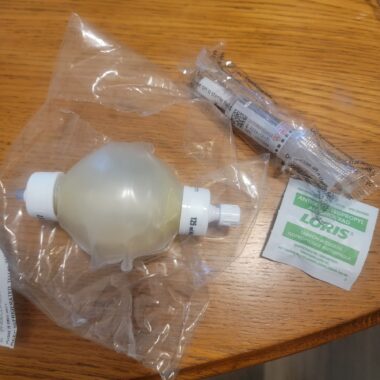A recent NMOSD attack led to new experience with home infusions
These treatments have advanced since this columnist's last attack

Note: This column describes the author’s own experiences with Solu-Medrol (methylprednisolone) and the Homepump Eclipse. Not everyone will have the same response to treatment. Consult your doctor before starting or stopping a therapy.
Initially, I took a blasé approach to my most recent neuromyelitis optica spectrum disorder (NMOSD) attack. When my vision started to disappear in the periphery of my left eye, I made a point to stay calm. I gave myself a day to rest, hoping my eyesight would return. But when it didn’t after two days, I hit the panic button.
What does panic look like for me? I calmly told my family what was going on and asked my husband to drive me to the emergency room. NMOSD has taught me that there’s no space for tears, anxiety, or hysteria — at least not when you’re in the throes of an attack.
As an immunocompromised patient, I avoid others who are potentially ill, such as those one would find in the ER. I was grateful when the nurses recognized my condition and put me in a private waiting room.
After spending the day at the ER, I was prescribed five days of Solu-Medrol. My first treatment was administered at the hospital. I’ve never been good with needles, but this time I knew I needed the medication, so I braced myself for the intravenous line to be placed in my hand.
I was clever and had brought along over-the-counter lidocaine cream. Lidocaine isn’t cheap; a tube of it here in Canada costs about CA$50 ($36). I liberally applied it an hour before the IV line was placed into my right hand, which made a huge difference.
Forging new treatment terrain
For the next four days, I needed a daily Solu-Medrol infusion. I had the option to go to a community care center, where nurses would administer the treatment, or have the medication and equipment sent to my home, where a community nurse would visit daily to assist me. I chose the latter.
When the medication arrived at my home, it was different from before. I was immediately confused because no IV pole arrived. When I opened the box, I found several items. The Solu-Medrol was in four balls, known as the Homepump Eclipse, a type of portable, balloon infusion pump that was new to me. Once plugged into the IV line, the ball slowly deflates, which is how you know it’s done.

Columnist Jennifer van Amerom uses the Homepump Eclipse infusion system for the first time recently. (Photo by Jennifer van Amerom)
I also found additional supplies to start my line again, if necessary, along with alcohol wipes and saline tubes to flush the line.
Unfortunately, the community nurse had to manage too many patients and couldn’t make it to my home until after 10 p.m. I started to get upset, because taking high doses of steroids right before bed would result in bad sleep. In addition, it’d be five hours past when I was supposed to receive my treatment.
If nothing else, NMOSD has made me brave, especially during attacks, so I decided to administer the treatment myself, which is not something I’d recommend. But in that moment, I felt confident in my skill set. I’d seen enough nurses hook me up to an IV line, so I steadied myself and went ahead with the plan. (I should note here to always follow the directions of your medical team. Describing my experiences here doesn’t necessarily mean they’re appropriate for you or other patients.)
I cleaned the top of the plug with the alcohol wipe. I flushed my line with the saline solution, and then attached the Eclipse pump. I was thankful that the supplies came with a pamphlet explaining how the pump worked. The most important note was to keep the medication ball below my hand; otherwise, it’d dispense much faster.
I always forget how painful Solu-Medrol is as it enters the body. The IV line always starts to hurt a little at the insertion site. After the ball deflated, I felt victorious and confidently unplugged myself. I flushed the line again with another saline tube.
One of the toughest things about five days of Solu-Medrol treatment, other than the brutal side effects I always feel, is living with an IV plug in my hand without blowing my veins and having to get another insertion. I survived three days with the same plug, but on day four, when I started to flush the line, my veins were screaming at me. So I visited the ER again and had them insert a new line into my other hand.
After my fifth treatment, which I was still doing by myself at home, I was allowed to take the plug out of my hand. This required help from my family. I had my husband pull the line out, and my daughter, who’s both brave and empathetic, was ready with gauze and tape to stop the bleeding once the line was out.
While I felt lost at times, I’m glad because it meant that it’s been a long time between attacks. Some things, such as how I receive my treatment at home, have changed.
Note: Neuromyelitis News is strictly a news and information website about the disease. It does not provide medical advice, diagnosis, or treatment. This content is not intended to be a substitute for professional medical advice, diagnosis, or treatment. Always seek the advice of your physician or other qualified health providers with any questions you may have regarding a medical condition. Never disregard professional medical advice or delay in seeking it because of something you have read on this website. The opinions expressed in this column are not those of Neuromyelitis News or its parent company, Bionews, and are intended to spark discussion about issues pertaining to neuromyelitis optica spectrum disorder.







Leave a comment
Fill in the required fields to post. Your email address will not be published.